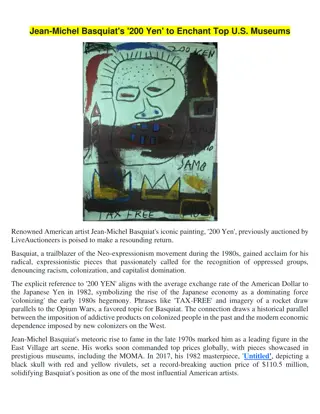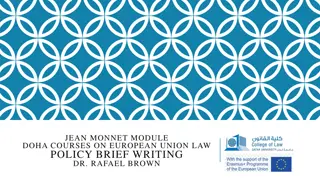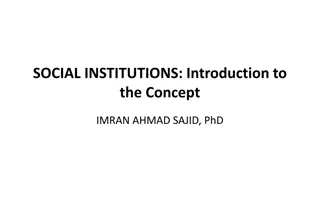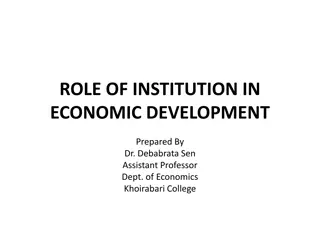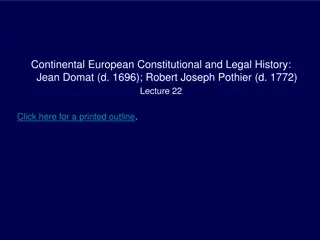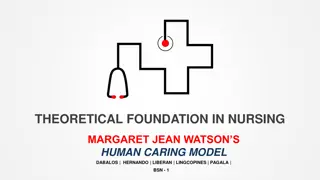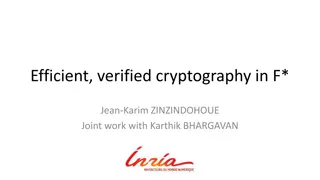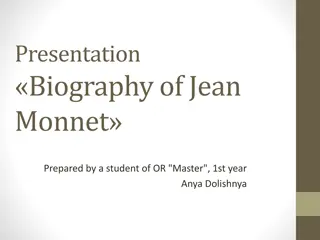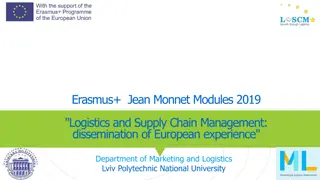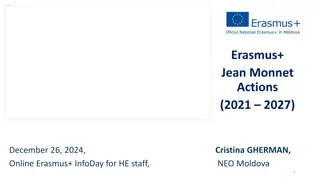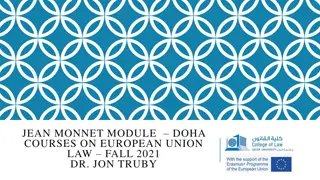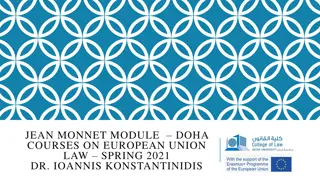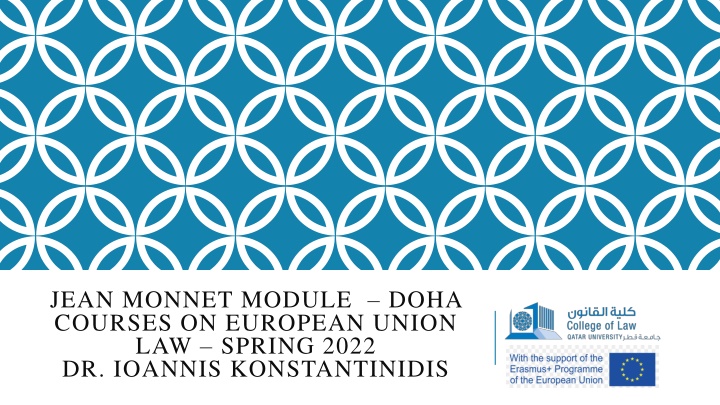
European Union Law: Jean Monnet Module Doha Courses on EU Institutions
Explore the Jean Monnet Module Doha courses on European Union law for Spring 2022 with a focus on the legal history and institutions of the EU. Delve into topics such as the Court of Auditors, European Central Bank, Committee of the Regions, agencies, and accountability issues. Gain an advanced understanding of the functions and working procedures of key EU institutions. Enhance your knowledge on the Court of Auditors' role in external budget audits, the ECB's significance in economic and monetary union, and the rationale behind establishing independent audit bodies. Discover the evolution and significance of these institutions within the EU framework.
Download Presentation

Please find below an Image/Link to download the presentation.
The content on the website is provided AS IS for your information and personal use only. It may not be sold, licensed, or shared on other websites without obtaining consent from the author. If you encounter any issues during the download, it is possible that the publisher has removed the file from their server.
You are allowed to download the files provided on this website for personal or commercial use, subject to the condition that they are used lawfully. All files are the property of their respective owners.
The content on the website is provided AS IS for your information and personal use only. It may not be sold, licensed, or shared on other websites without obtaining consent from the author.
E N D
Presentation Transcript
JEAN MONNET MODULE DOHA COURSES ON EUROPEAN UNION LAW SPRING 2022 DR. IOANNIS KONSTANTINIDIS
COURSE 1: THE EUROPEAN UNION: LEGAL HISTORY AND INSTITUTIONS WEEK 6 I. The Court of Auditors II. The European Central Bank III. The Committee of the Regions IV. Agencies V. Accountability and transparency
WEEK 5 Learning Outcomes: On completion of this week, students should Have developed an advanced understanding of the functions, composition and working procedures of the Court of Auditors, the European Central Bank and the Committee of the Regions Have developed an understanding of accountability issues in the European Union
I. THE COURT OF AUDITORS The Court of Auditors
I. THE COURT OF AUDITORS The Court of Auditors Established by an amendment to the Treaties in 1975 It is not, strictly speaking, a court, but more an audit commission It is responsible for the external audit of the general budget of the Union. The internal audit is the responsibility of the Financial Controller of each institution
I. THE COURT OF AUDITORS The Court of Auditors Rationale Desire of some of the newer Member States to establish more effective audit arrangements Desire of the European Parliament to have greater power in the financial affairs of the Union An independent audit body is seen by the European Parliament as an important part of establishing greater financial control. It had, initially, the status of a separate body but, since the TEU came into effect in 1993, it has been classed as one of the Union institutions
II. THE EUROPEAN CENTRAL BANK The European Central Bank
II. THE EUROPEAN CENTRAL BANK The European Central Bank Article 13(1) TEU recognizes the European Central Bank (ECB) as one of the Union institutions The ECB was initially set up as part of the progression towards economic and monetary union
II. THE EUROPEAN CENTRAL BANK The European Central Bank The ECB has legal personality and can enact legislation, impose fines, submit opinions and be consulted within its field of operation The ECB works with the national banks of the Member States to form the European System of Central Banks (ESCB). The main purpose of the ESCB is to maintain price stability Additionally, the ECB works with the national banks of the Member States whose currency is the euro to form the Eurosystem, through which they conduct the monetary policy of the Union
III. THE COMMITTEE OF THE REGIONS The Committee of the Regions
III. THE COMMITTEE OF THE REGIONS What is the rationale behind the creation of the Committee of the Regions? The Committee of the Regions is not recognized by Article 13(1) TEU as one of the Union institutions but is mentioned in Art 13(4) TEU It was intended to represent a move towards more region-orientated decision-making and to create an ever closer union among the peoples of Europe
III. THE COMMITTEE OF THE REGIONS Functions Prior to the ToL: its principal role was to deliver opinions on legislation when consulted by the European Parliament, the Council or the Commission It issued opinions on its own initiative in appropriate cases (Art 307 TFEU) Its members are not bound by mandatory instructions and members are completely independent in the performance of their duties
III. THE COMMITTEE OF THE REGIONS Functions After the entry into force of the ToL: the Committee has been given the additional power to challenge legislative proposals it considers to be in breach of the principle of subsidiarity The President of the Committee of the Regions, or the Committee s member who is responsible for drawing up the draft opinion, may propose that an action be brought before the Court of Justice
III. THE COMMITTEE OF THE REGIONS Composition Members are appointed for a period of five years and they may be reappointed Seats are allocated according to the relative population of each Member State. The number of members of the Committee of the Regions shall not exceed 350 Members need to have an electoral mandate to represent citizens at a local level. No member of the Committee shall at the same time be a Member of the European Parliament
IV. AGENCIES Agencies EU agencies are independent legal entities, distinct from the main Union institutions, which are created by secondary legislation to perform specific tasks There are two main types of agency
IV. AGENCIES Agencies Decentralized agencies: established for an indefinite period of time and are situated throughout the Union They contribute to the implementation of EU policies within a particular policy area Examples include the European Environment Agency, the European Food Safety Authority
IV. AGENCIES Agencies Executive agencies: established by the Commission for a limited period of time to manage specific tasks For example, the Research Executive Agency was established to assist the Commission in achieving specific objectives related to research and technological development in the EU
V. ACCOUNTABILITY AND TRANSPARENCY Democratic accountability EU: an organization having a double democratic mandate through a Parliament representing EU citizens and a Council representing the elected governments of the Member States Common criticism: it lacks direct democratic accountability to its citizens. This argument reflects the limited powers of the European Parliament, which is the only institution where citizens directly elect the members that represent them at the Union level
V. ACCOUNTABILITY AND TRANSPARENCY Democratic accountability The role of Parliament in the legislative process has been strengthened following amendments to the EU Treaties Co-decision procedure placing the Parliament on an equal footing with the Council in the legislative process. This procedure, which now applies in the vast majority of cases, was renamed as the ordinary legislative procedure
V. ACCOUNTABILITY AND TRANSPARENCY Democratic accountability It can also be argued that a democratic deficit remains in relation to Parliament s inability to dismiss individual Commissioners and to hold members of the Council to account Although Council documents are now available after meetings and Council deliberations on legislative acts are now open to the public, other meetings of the Council generally take place behind closed doors
V. ACCOUNTABILITY AND TRANSPARENCY Transparency The Commission adopted a decision on public access to Commission documents in February 1994. This implemented a joint code of conduct between the Commission and the Council The general principle is that the public should have the widest possible access to documents held by these two institutions, subject to public or private interests being protected
V. ACCOUNTABILITY AND TRANSPARENCY Transparency in the Commission Green Papers are communications published by the Commission on a specific policy area. Primarily they are documents addressed to interested parties, organizations and individuals, who are invited to participate in a process of consultation and debate White Papers, which often follow a Green Paper, are documents containing proposals for Union action in a specific area. While Green Papers set out a range of ideas presented for public discussion and debate, White Papers contain an official set of proposals in specific policy areas
V. ACCOUNTABILITY AND TRANSPARENCY Transparency in the Council Discussions in the Council have previously been held in secret However, in order to meet the requirement of transparency, Article 16(8) TEU now provides that the Council will meet in public when it deliberates and votes on a draft legislative act
V. ACCOUNTABILITY AND TRANSPARENCY Transparency of the Parliament 13 December 2016: the Parliament adopted changes to its Rules of Procedure with the aim of enhancing the transparency and efficiency of the institution The changes require MEPs to make more frequent and detailed declarations of their financial interests and bans MEPs from taking paid lobbying jobs whilst in office In addition, the rules provide for greater scrutiny by the Parliament of Commissioners potential conflicts of interest, both at the beginning of their term and at any point when there are significant changes to a Commissioner s portfolios or interests
NEXT WEEK: POLICY BRIEF WRITING Readings Per the course syllabus

